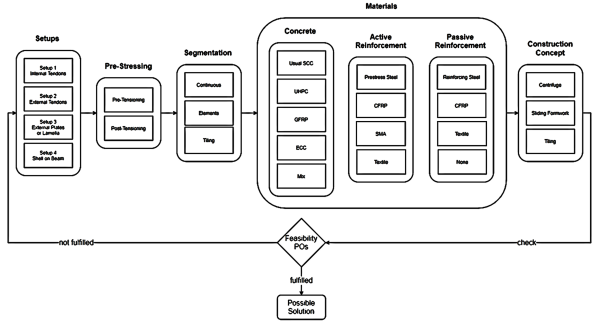Structural design for EuroTube
Author: Oliver Wach
Language: English
Abstract
In this Master’s Thesis, the structural feasibility and challenges for vacuum hyperloop infrastructure made of concrete are investigated. This investigation is done in collaboration with EuroTube, a non-profit organisation in Zürich. EuroTupe is working on its pilot project AlphaTube, which will include the construction of a testing and research facility for high-speed vacuum transportation, open for research and industry.
The task in this thesis was to analyse different possible design solutions of the tube in a variation study before selecting one of them for in-depth structural design. This thesis does not constitute a final design report. Instead, it serves as a guideline for the structural challenges by offering preliminary analytical results of specific design problems.
The starting point is given by EuroTube’s POs, which limit the maximum weight of the 20 m segments to 45 tons and the displacement experienced by the hyperloop vehicle to 2 mm. The project’s complexity is highlighted at the beginning of the variation study to get an overview of possible design solutions.
Afterwards, conceptual considerations and first analytical investigations are conducted to find the most effective system for the structural design study.
The selected system for the structural design includes a post-tensioned and segmented concrete tube made of high-performance concrete, prestressing and reinforcing steel. As an exceptional but innovative design solution, the structural impact of so-called tiles is investigated. These tiles have a resemblance with tubbing elements from typical tunnelling projects.
After identifying and analysing all main structural challenges, it is concluded that aiming for a 2 mm displacement experienced by the vehicle is structurally not feasible. The long-term effects of concrete make it impossible to achieve such an accurate performance, already before intolerances, material variances, dynamic effects, geotechnical settlements, etc., are included in the analysis. Therefore, it is proposed to counteract local and inacceptable displacements with a tailor-made solution separated from the structure, e.g. a sophisticated subtract levelling system with presses. A precambering of the latter should also be part of the discussion since it could help to neutralise the tube’s initial displacements.
Other identified structural challenges such as the structural weakening effect of longitudinal joints (resulting from the tiling concept) or the shear force concentration at the supports should be tackled by changing the design and optimising the geometry.




